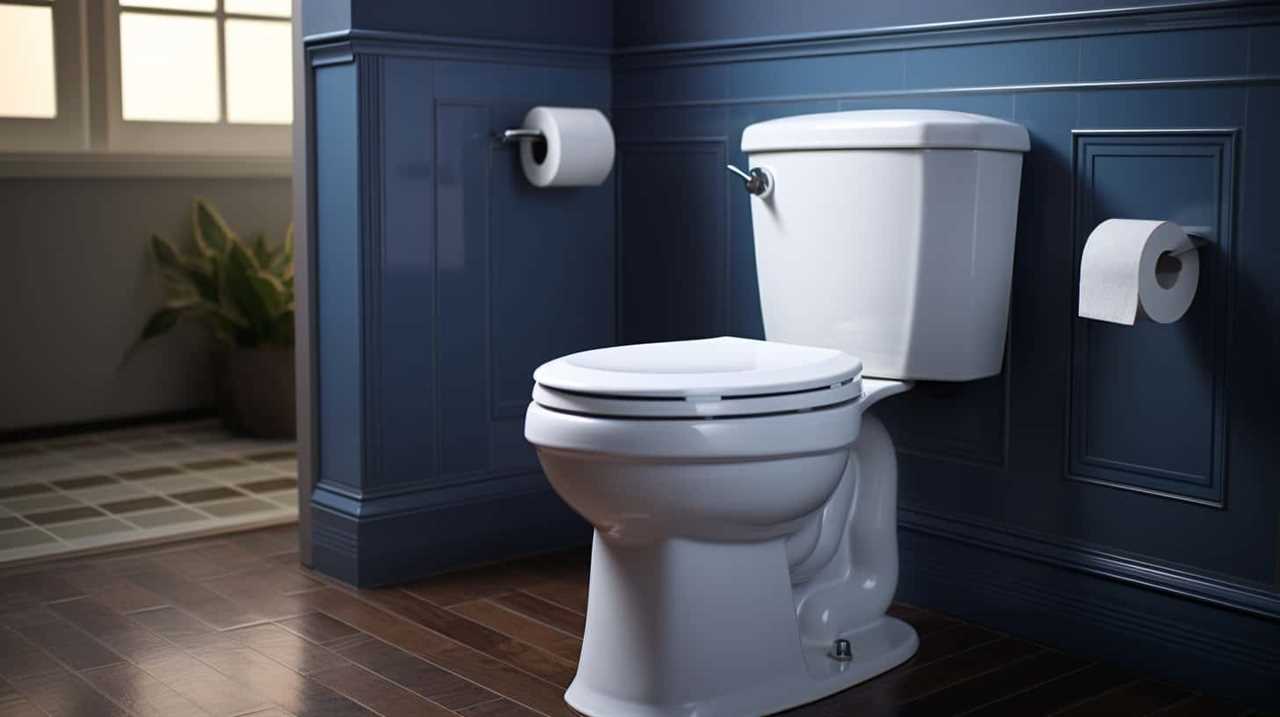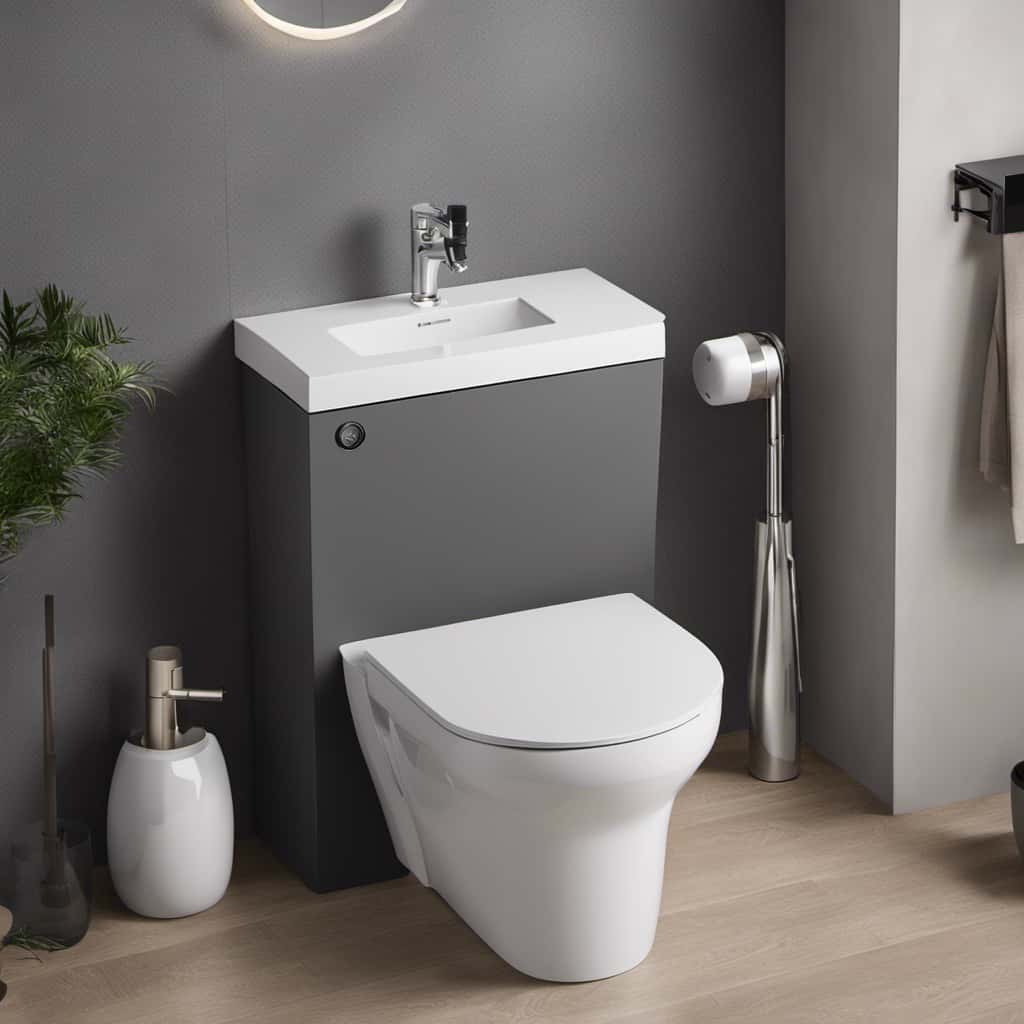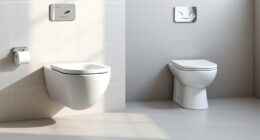Have you ever pondered whether a clog caused by toilet paper will eventually disintegrate?
In our quest for mastery over bathroom mishaps, we delve into the depths of this conundrum. Join us as we explore the composition of toilet paper and how it breaks down in water.
Discover the factors that affect its dissolvability and the potential risks of using non-dissolvable varieties.
Fear not, for we shall also impart tips to prevent toilet paper clogs and maintain our porcelain thrones in pristine condition.

Key Takeaways
- Toilet paper is designed to easily disintegrate in water through a process of fiber absorption, weakening, and separation.
- Factors such as fiber composition and manufacturing process can affect the dissolvability of toilet paper.
- Non-dissolvable toilet paper can have negative environmental impacts, cause plumbing issues, and lead to costly repairs.
- Preventing toilet paper clogs through proper disposal, moderation in usage, and mindful choices can save money, ensure a hygienic environment, and contribute to a smooth-functioning plumbing system.
The Composition of Toilet Paper
To understand the potential for a toilet paper clog to eventually dissolve, it’s important to examine the composition of toilet paper. Toilet paper is typically made from a combination of virgin pulp and recycled paper. The manufacturing process starts by breaking down the wood fibers into a pulp, which is then mixed with water and chemicals to create a slurry. This slurry is then spread onto a wire mesh screen and pressed to remove excess water. Next, the paper is dried and rolled into large rolls, which are then cut into smaller rolls for consumer use.
While toilet paper is primarily made from wood fibers, additives such as bleach and chemicals are often used during the manufacturing process to enhance its softness and strength. These additives can potentially affect the rate at which toilet paper dissolves in water.
The environmental impact of toilet paper production is a matter of concern. The manufacturing process requires a significant amount of water and energy, and the use of virgin wood pulp contributes to deforestation. However, some toilet paper brands have made efforts to use more sustainable materials, such as bamboo or recycled paper, to reduce their environmental impact.
How Toilet Paper Breaks Down in Water
We can observe how toilet paper breaks down in water by conducting a simple experiment. When toilet paper is exposed to water, it undergoes a decomposition process. The individual fibers that make up the toilet paper begin to separate and weaken as they absorb water. This process is facilitated by the fact that toilet paper is specifically designed to be easily disintegrated in water. As the fibers break down, the toilet paper gradually disintegrates into smaller pieces.

This decomposition process is crucial for the efficient disposal of toilet paper, as it allows for easier flushing and prevents clogs in plumbing systems. Additionally, understanding the environmental impact of toilet paper breakdown is important, as it helps us make more sustainable choices in our consumption and disposal habits.
Transitioning into the next section about factors that affect toilet paper dissolvability, we can now explore the various factors that influence how quickly or effectively toilet paper breaks down in water.
Factors That Affect Toilet Paper Dissolvability
As we explore the factors that affect toilet paper dissolvability, it becomes evident that certain variables play a crucial role in determining how quickly or effectively toilet paper breaks down in water. Understanding these factors is important for both consumers and manufacturers.
Here are three key factors that impact toilet paper dissolvability:

- Toilet paper manufacturing process:
The way toilet paper is manufactured can greatly influence its dissolvability. Certain manufacturing techniques, such as using shorter fibers or adding chemicals, can result in toilet paper that takes longer to break down in water. - Fiber composition:
The type of fibers used in toilet paper can affect its dissolvability. Toilet paper made from softer fibers, like virgin pulp, tends to break down more easily than paper made from recycled fibers. - Environmental impact of non-dissolvable toilet paper:
Non-dissolvable toilet paper can have a significant negative impact on the environment. When flushed, it can contribute to clogs in sewage systems and increase the risk of blockages, leading to costly repairs and potential pollution.
Potential Risks of Using Non-Dissolvable Toilet Paper
Our research shows that the potential risks of using non-dissolvable toilet paper are significant. Not only does it have a negative environmental impact, but it can also lead to plumbing issues and costly repairs. Non-dissolvable toilet paper does not break down easily in water, causing it to accumulate in pipes and create clogs. These clogs can result in blocked drains and toilets, leading to backups and potential water damage. To illustrate the risks, consider the following table:
| Potential Risks of Using Non-Dissolvable Toilet Paper |
|---|
| Negative environmental impact |
| Plumbing issues and clogs |
| Costly repairs |
To avoid these risks, it is advisable to explore alternatives to non-dissolvable toilet paper. Some options include biodegradable toilet paper, bamboo toilet paper, or even bidets. These alternatives are more environmentally friendly and reduce the chances of plumbing problems. By making a conscious choice to switch to a more dissolvable and sustainable option, we can minimize the potential risks associated with non-dissolvable toilet paper.
Tips to Prevent Toilet Paper Clogs
To prevent toilet paper clogs, it’s essential to properly dispose of large amounts of toilet paper. Here are some tips to help you prevent clogs and maintain a smooth-functioning plumbing system:
- Use the right amount: Avoid using excessive amounts of toilet paper. Moderation is key to preventing clogs.
- Flush multiple times if needed: If you’ve used a substantial amount of toilet paper, consider flushing multiple times to ensure everything is properly disposed of.
- Consider toilet paper alternatives: Explore eco-friendly toilet paper options that are designed to dissolve easily, reducing the risk of clogs and minimizing environmental impact.
Frequently Asked Questions
What Are Some Alternative Materials to Toilet Paper That Can Be Used Without the Risk of Clogging?
Eco friendly toilet paper alternatives include bidets, which have pros and cons. Bidets use water to clean, reducing the need for toilet paper. They are precise and efficient, offering a mastery of hygiene.

Can Using Too Much Toilet Paper at Once Lead to Clogs?
Yes, using too much toilet paper at once can lead to plumbing issues. Flushing excessive toilet paper causes clogs in the toilet. It’s like pouring sand down a narrow pipe; eventually, it will block the flow.
How Long Does It Typically Take for Toilet Paper to Dissolve in Water?
Toilet paper dissolves in water, but the time it takes varies. Factors such as the type and thickness of the paper, water temperature, and plumbing conditions can affect dissolution.
Are There Any Specific Brands of Toilet Paper That Are More Likely to Cause Clogs?
When it comes to preventing toilet paper clogs, there are no specific brands that guarantee success. However, using techniques like regular maintenance and choosing eco-friendly options can help minimize the risk of clogs.
What Are Some Signs That Your Toilet May Be Clogged With Toilet Paper?
Warning signs that your toilet may be clogged with toilet paper include slow drainage, water rising to the brim, and gurgling sounds. Prevention methods involve using less toilet paper, regular maintenance, and avoiding flushing non-flushable items.

Conclusion
In conclusion, toilet paper will eventually dissolve when flushed down the toilet. The composition of toilet paper allows it to break down easily in water, reducing the risk of clogs.
However, it’s important to consider factors that can affect toilet paper dissolvability, such as the quality and thickness of the paper.
Using non-dissolvable toilet paper may pose a risk of clogs, so it’s recommended to choose a toilet paper that’s designed to dissolve easily.
Remember these tips to keep your pipes flowing smoothly!











